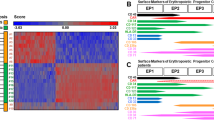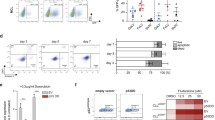Abstract
Friend erythroleukaemia virus (FLV) is a type-C marine retrovirus that induces a rapid multi-stage erythroleukaemia in susceptible mice1–5. An early phase (1–3 weeks) is characterized by splenomegaly and rapid changes in erythropoiesis5–8, while a later stage (1–3 months) is associated with the development of clones of highly tumorigenic cells2–5,9, which can be established into Friend erythroleukaemic cell lines. Two distinct isolates of FLVs, both of which can induce the early and late stages of the diseases, have been described. The original isolate (FV-A)1 induces a rapid severe anaemia1, while a later isolate (FV-P)10, derived from stocks of FV-A, induces a rapid polycythaemia7. In addition to the contrasting changes in haematocrit, the diseases induced by FV-A and FV-P can also be distinguished. For example, while the erythropoiesis in FV-A infected mice appears to remain under the control of the hormone erythropoietin8,11,12, erythropoiesis in FV-P infected mice is erythropoietin-independent8,11–13. Furthermore, Friend erythroleukaemic cell lines derived as a consequence of FV-A and FV-P infection also display different cellular properties5,9,14. Here we demonstrate that in addition to the viral contributions, host genes play an important part in determining the nature of the disease induced by FV-A or FV-P. A new host gene which determines the induction of early anaemia or polycythaemia by FLV is described.
This is a preview of subscription content, access via your institution
Access options
Subscribe to this journal
Receive 51 print issues and online access
$199.00 per year
only $3.90 per issue
Buy this article
- Purchase on Springer Link
- Instant access to full article PDF
Prices may be subject to local taxes which are calculated during checkout
Similar content being viewed by others
References
Friend, C. J. exp. Med. 105, 307–318 (1957).
Friend, C. & Haddad, J. R. J. natn. Cancer Inst. 25, 1279–1289 (1960).
Ostertag, W., Melderis, H., Steinheider, G., Kluge, N. & Dube, S. Nature new Biol. 239, 231–234 (1972).
Mager, D., Mak, T. W. & Bernstein, A. Nature 288, 592–594 (1980).
Mager, D. L., Mak, T. W. & Bernstein, A. A. Proc. natn. Acad. Sci. U.S.A. 78, 1703–1707 (1981).
Tambourin, P., Wendling, F., Moreau-Gachelin, F., Charon, M. & Bucau-Varlet, P. in In Vivo and In Vitro Erythropoiesis: The Friend System (ed. Rossi, G. B.) 127–138 (Elsevier, Amsterdam, 1980).
Horoszewicz, J. S., Leong, S. S. & Carter, W. A. J. natn. Cancer Inst. 54, 265–267 (1975).
MacDonald, M. E. et al. J. exp. Med. 151, 1477–1492 (1980).
Mager, D. L., MacDonald, M. E., Robson, I. B., Mak, T. W. & Bernstein, A. J. molec. Cell Biol. 1, 721–730 (1981).
Mirand, E. A., Prentice, T. C. & Hoffman, J. G. Proc. Soc. exp. Biol. Med. 106, 423–426 (1961).
Fagg, B., Vehmeyer, K., Ostertag, W., Jasmin, C. & Klein, B. in In Vivo and In Vitro Erythropoiesis: The Friend System (ed. Rossi, G. B.) 163–172 (Elsevier, Amsterdam, 1980).
Peschle, C. et al. Proc. natn. Acad. Sci. U.S.A. 77, 2054–2058 (1980).
Liao, S. K. & Axelrad, A. A. Int. J. Cancer 15, 467–482 (1975).
Kluge, N., Gaedicke, G., Steinheidev, G., Duke, S. & Ostertag, W. Expl Cell Res. 88, 257–262 (1974).
Steeves, R. & Lilly, R. A. Rev. Genet. 11, 277–296 (1977).
Mak, T. W., Gamble, C. L., MacDonald, M. E. & Bernstein, A. Cold Spring Harb. Symp. quant. Biol. 44, 893–898 (1980).
Yamamoto, Y. et al. Proc. natn. Acad. Sci. U.S.A. 78, 6893–6897 (1981).
Odaka, T. Int. J. Cancer 16, 18–23 (1970).
Lilly, F. J. natn. Cancer Inst. 45, 163–169 (1970).
Steeves, R. A., Bennett, M., Mirand, E. A. & Cudkowicz, G. Nature 218, 372–374 (1968).
Bennett, M., Steeves, R. A., Cudkowicz, G., Mirand, E. A. & Russell, L. B. Science 162, 564–565 (1968).
McCool, D., Mak, T. W. & Bernstein, A. J. exp. Med. 149, 837–846 (1979).
Lilly, F. J. exp. Med. 127, 465–473 (1968).
Author information
Authors and Affiliations
Rights and permissions
About this article
Cite this article
Shibuya, T., Mak, T. A host gene controlling early anaemia or polycythaemia induced by Friend erythroleukaemia virus. Nature 296, 577–579 (1982). https://doi.org/10.1038/296577a0
Received:
Accepted:
Published:
Issue Date:
DOI: https://doi.org/10.1038/296577a0
This article is cited by
-
Fv2 encodes a truncated form of the Stk receptor tyrosine kinase
Nature Genetics (1999)
Comments
By submitting a comment you agree to abide by our Terms and Community Guidelines. If you find something abusive or that does not comply with our terms or guidelines please flag it as inappropriate.



